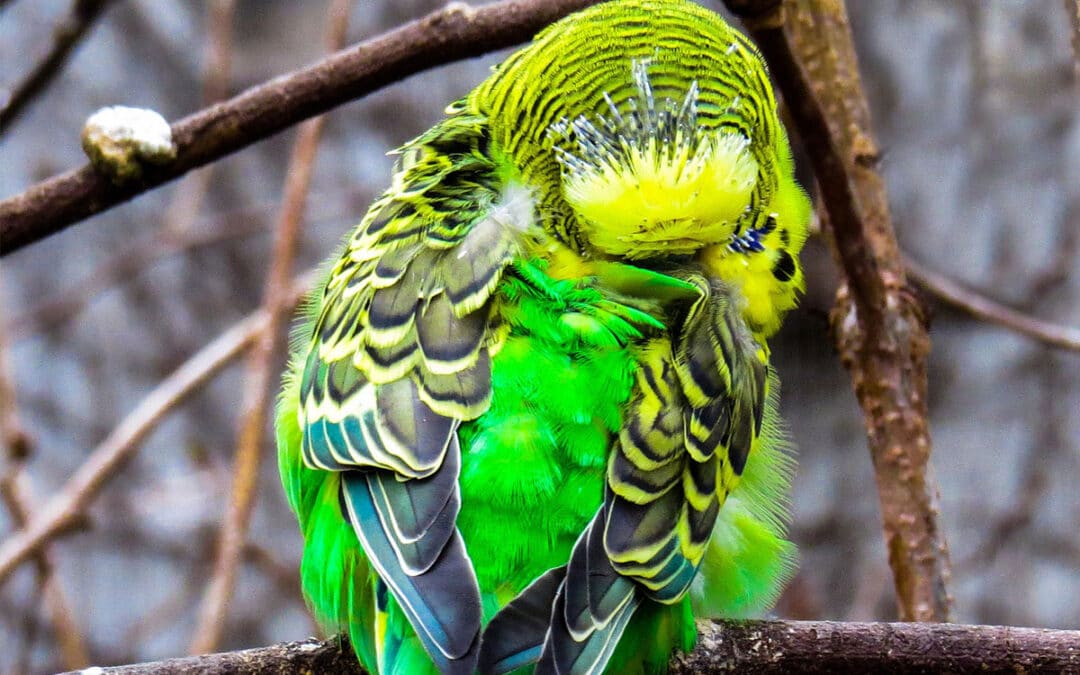Budgies, also known as parakeets, are fascinating creatures with unique sleep patterns and needs.
As pet owners, it’s essential to understand these patterns to ensure that our feathered friends are getting the rest they need to stay healthy and happy.
In this article, we’ll explore the sleep patterns of budgies, the reasons why they sleep the way they do and how to provide a comfortable and safe environment for them to rest.
The Sleep Patterns of Budgies
Budgies are active birds that need around 8-10 hours of sleep per day. They tend to sleep in short intervals throughout the day and night, usually in blocks of around 20-30 minutes. This is known as polyphasic sleep and is typical of most birds.
During the day, budgies tend to nap after they have been active or eating. This is known as diurnal sleep and is a natural habit of most birds. Budgies also sleep in the night, usually in blocks of around 2-3 hours. This is known as nocturnal sleep and is also a natural habit of most birds.
Budgies sleep patterns are different from humans, they don’t have a consolidated sleep period and instead, they take multiple naps throughout the day, this is why it’s essential to provide them with a comfortable and safe environment to sleep. They are also affected by the amount of light they receive during the day, in the wild, they would sleep when the sun goes down, and wake up when the sun rises.
It’s essential to understand that the sleep patterns of budgies are based on their natural behavior and the environment they live in. By providing them with a comfortable and safe environment, we can ensure that our feathered friends are getting the rest they need to stay healthy and happy.
The Reasons Behind Budgies’ Sleep Patterns
Budgies’ sleep patterns are influenced by their natural behavior and the environment they live in. In the wild, they need to be alert to protect themselves from predators and to find food. Therefore, they tend to take short naps, so they can be ready for any potential danger.
Additionally, their sleep patterns are influenced by the amount of light they receive during the day. In the wild, they would sleep when the sun goes down, and wake up when the sun rises, which is why it’s essential to provide them with enough natural light or UVB lighting.
How to Provide a Comfortable and Safe Sleep Environment for Budgies
To ensure that your budgie is getting the rest it needs, it’s essential to provide a comfortable and safe sleep environment. This means creating a quiet and dark space for them to sleep in, such as a cage cover or a sleep tent. It’s also important to provide them with a soft and comfortable perch to rest on, as well as a variety of different perches to sleep in different positions.
Additionally, it’s essential to provide them with access to natural light or UVB lighting during the day and to limit noise and activity during the night.
The Importance of Proper Cage Placement
The placement of your budgie’s cage in the room is crucial for their overall health and well-being. It not only affects their physical health, but also their mental and emotional state. Here are some things to consider when choosing the perfect spot for your budgie’s cage:
- Natural light: Budgies need access to natural light or UVB lighting to maintain their physical and mental health. Place the cage near a window or provide a UVB light in the room.
- Temperature: Budgies are sensitive to temperature changes, and too much heat or cold can be harmful to them. Avoid placing the cage near drafts or heat sources, and keep the room temperature between 60-80°F (15-27°C).
- Noise level: Budgies need a quiet and peaceful environment to sleep. Avoid placing the cage in a high-traffic area or near loud appliances.
- Interaction: Budgies are social creatures and need interaction with their owners. Place the cage in a room where you spend a lot of time, such as the living room or a home office.
By considering these factors and placing the cage in an appropriate location, you can ensure that your budgie is comfortable and healthy. Remember that budgies need to be in a room where people spend a lot of time, so they can be socialized and feel less lonely.
In conclusion, budgies have unique sleep patterns and needs that are influenced by their natural behavior and the environment they live in. By understanding these patterns and providing a comfortable and safe sleep environment, we can ensure that our feathered friends are getting the rest they need to stay healthy and happy.
Remember to provide enough natural light or UVB lighting, to limit noise and activity during the night and to create a comfortable and safe space for them to sleep.

